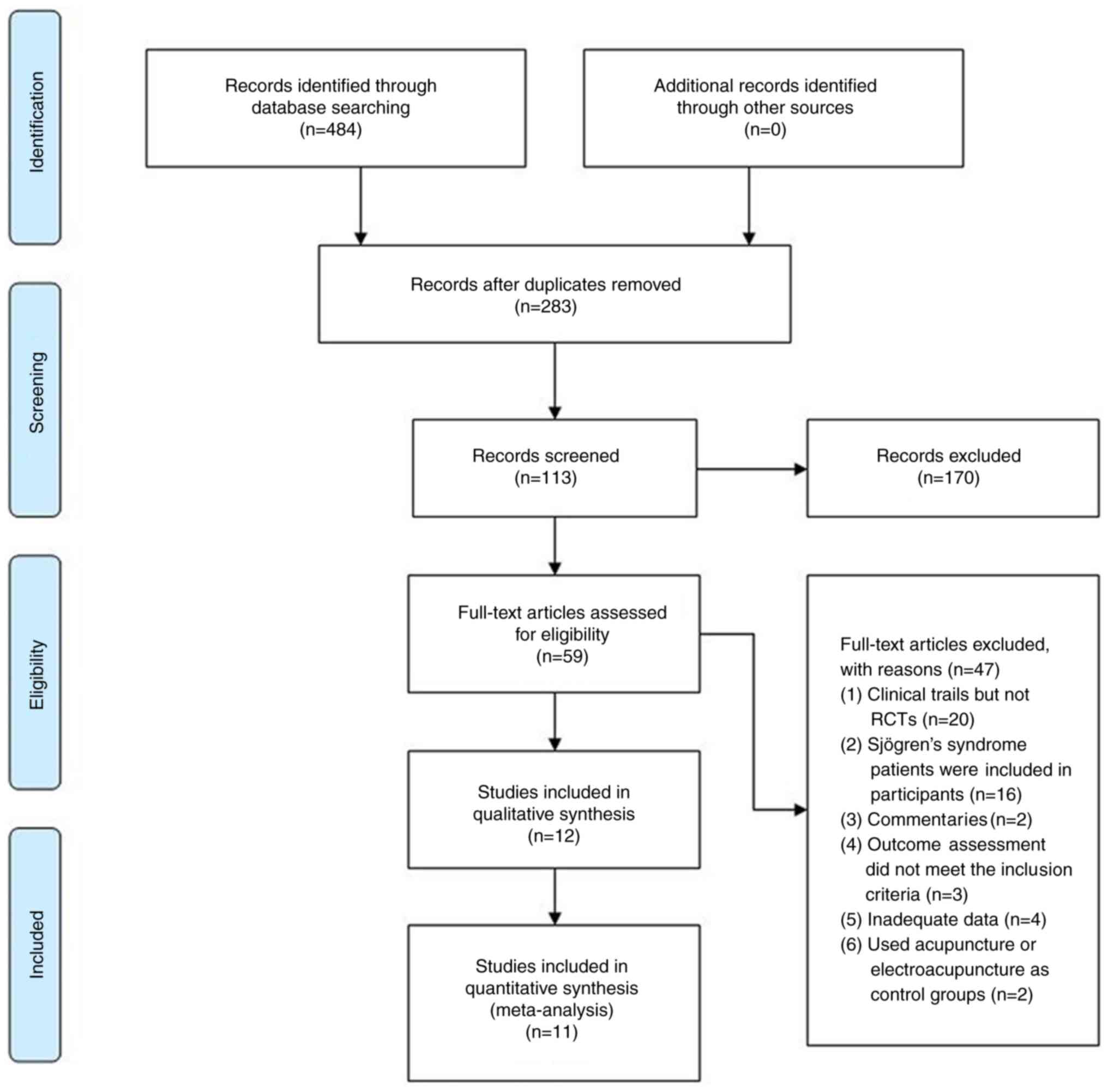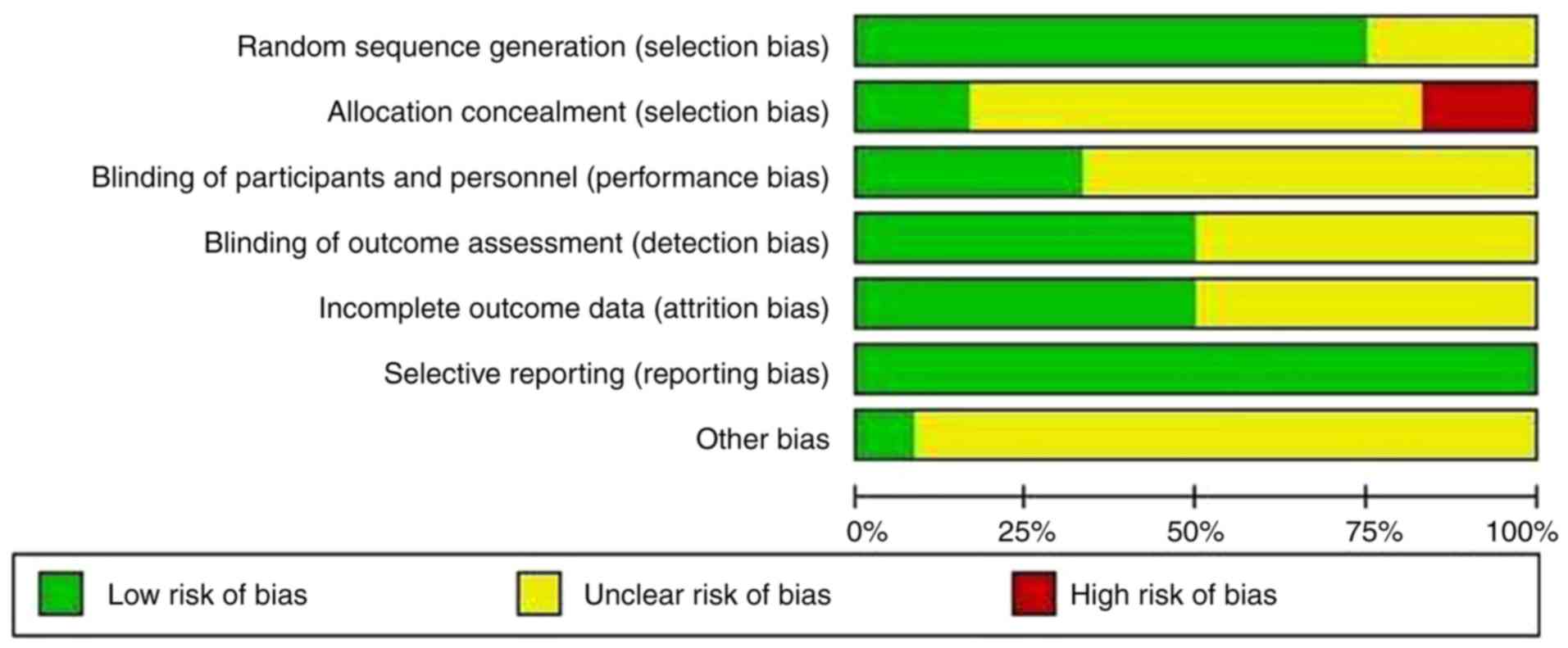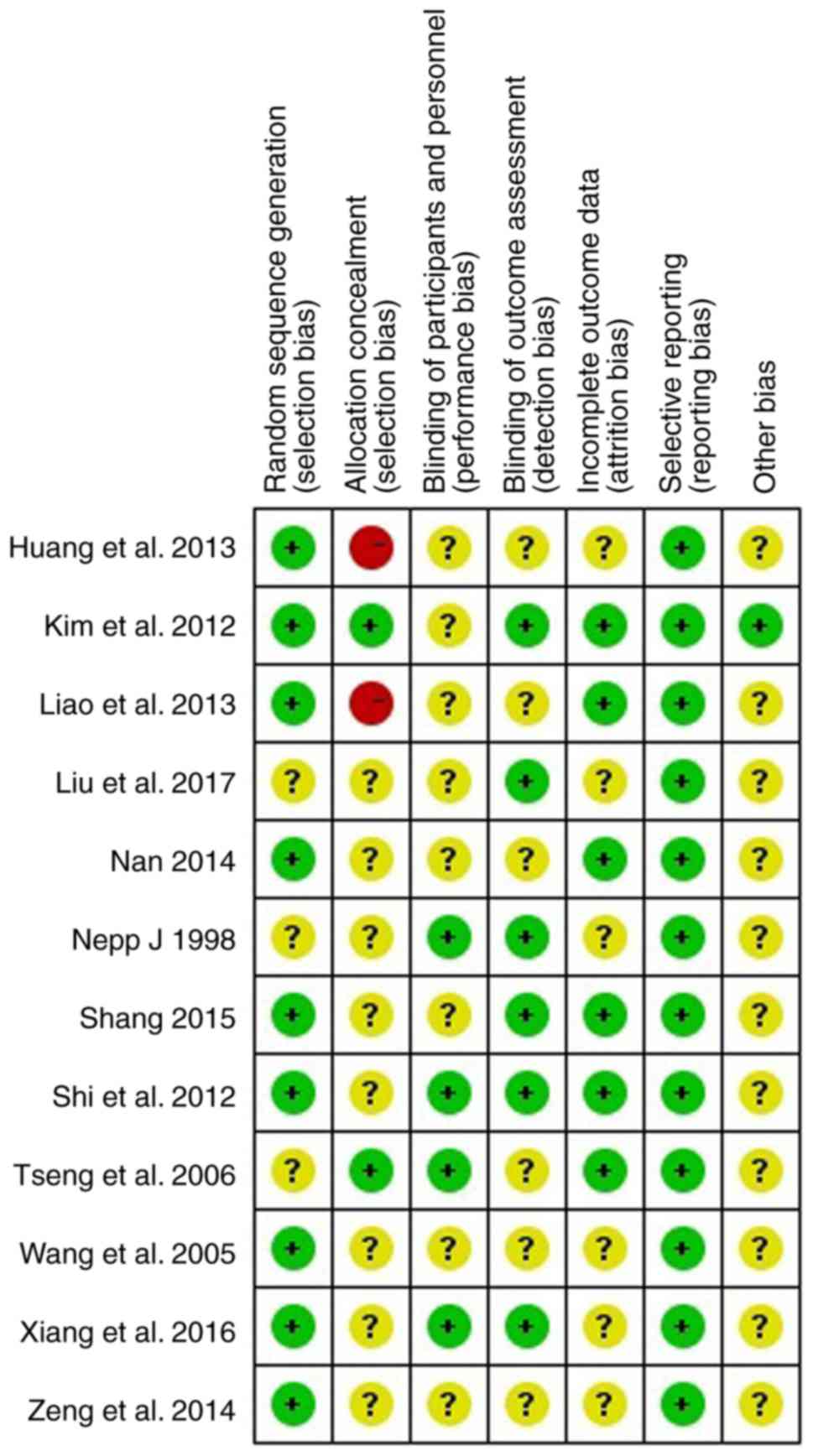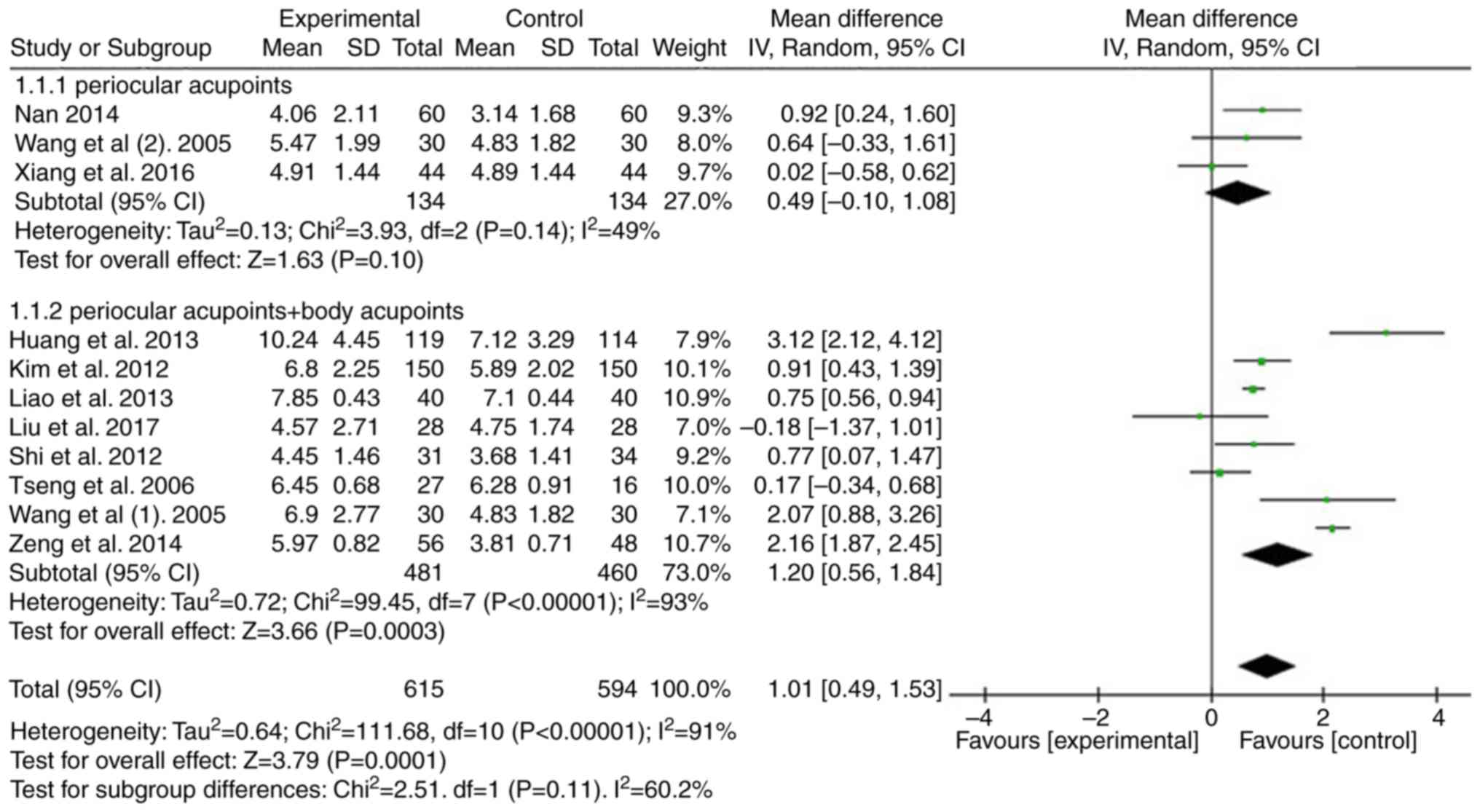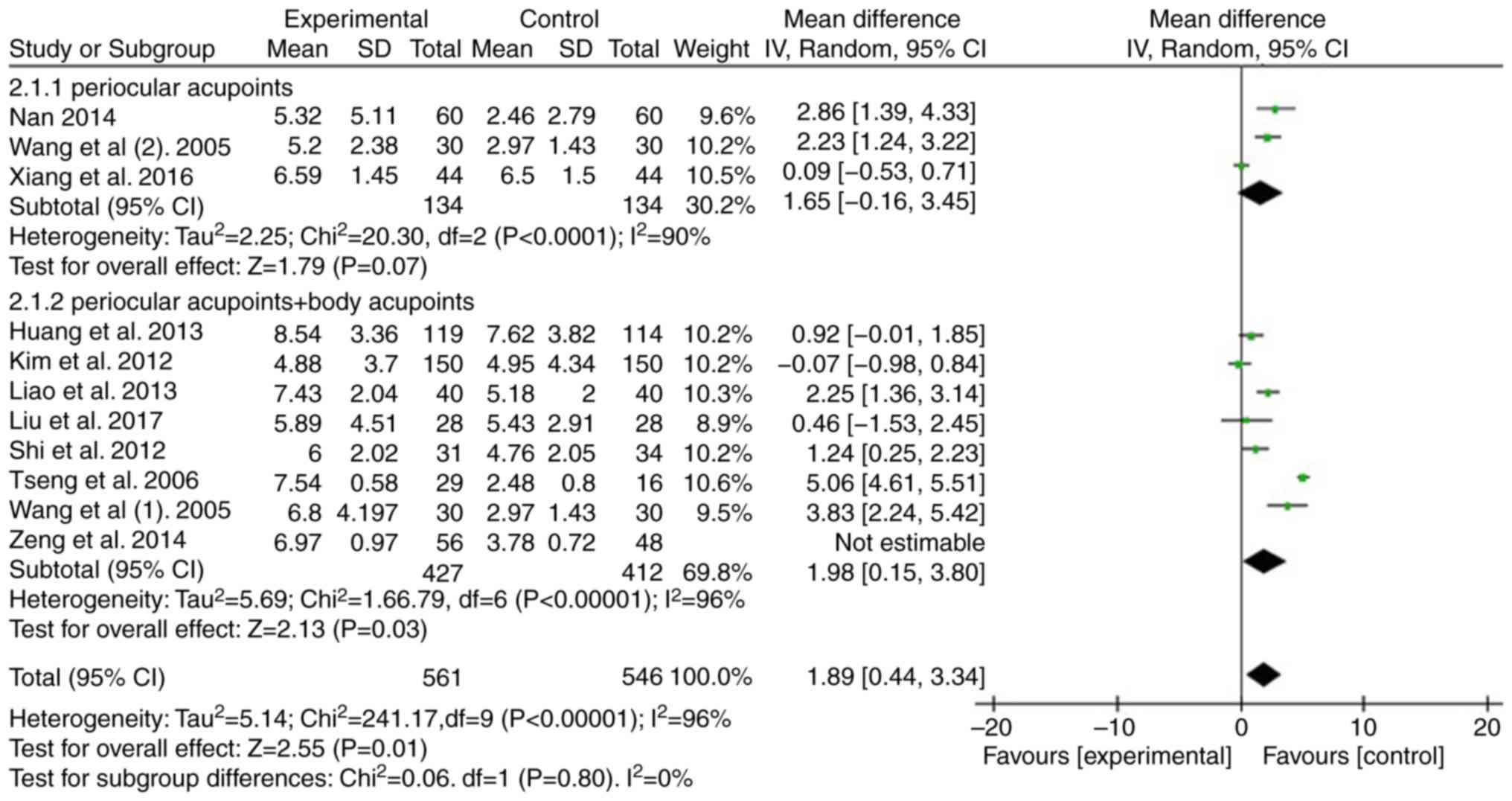|
1
|
Craig JP, Nichols KK, Akpek EK, Caffery B,
Dua HS, Joo CK, Liu Z, Nelson JD, Nichols JJ, Tsubota K and
Stapleton F: TFOS DEWS II definition and classification report.
Ocul Surf. 15:276–283. 2017.PubMed/NCBI View Article : Google Scholar
|
|
2
|
Sriprasert I, Warren DW, Mircheff AK and
Stanczyk FZ: Dry eye in postmenopausal women: A hormonal disorder.
Menopause. 23:343–351. 2016.PubMed/NCBI View Article : Google Scholar
|
|
3
|
Qiu X, Gong L, Sun X and Jin H:
Age-related variations of human tear meniscus and diagnosis of dry
eye with Fourier-domain anterior segment optical coherence
tomography. Cornea. 30:543–549. 2011.PubMed/NCBI View Article : Google Scholar
|
|
4
|
Gayton JL: Etiology, prevalence, and
treatment of dry eye disease. Clin Ophthalmol. 3:405–412.
2009.PubMed/NCBI View Article : Google Scholar
|
|
5
|
Donnenfeld ED, Ehrenhaus M, Solomon R,
Mazurek J, Rozell JC and Perry HD: Effect of hinge width on corneal
sensation and dry eye after laser in situ keratomileusis. J
Cataract Refract Surg. 30:790–797. 2004.PubMed/NCBI View Article : Google Scholar
|
|
6
|
Moon JH, Lee MY and Moon NJ: Association
between video display terminal use and dry eye disease in school
children. J Pediatr Ophthalmol Strabismus. 51:87–92.
2014.PubMed/NCBI View Article : Google Scholar
|
|
7
|
Nakamura S, Kinoshita S, Yokoi N, Ogawa Y,
Shibuya M, Nakashima H, Hisamura R, Imada T, Imagawa T, Uehara M,
et al: Lacrimal hypofunction as a new mechanism of dry eye in
visual display terminal users. PLoS One. 5(e11119)2010.PubMed/NCBI View Article : Google Scholar
|
|
8
|
Iyer JV, Lee SY and Tong L: The dry eye
disease activity log study. ScientificWorldJournal.
2012(589875)2012.PubMed/NCBI View Article : Google Scholar
|
|
9
|
Terry MA: Dry eye in the elderly. Drugs
Aging. 18:101–107. 2001.PubMed/NCBI View Article : Google Scholar
|
|
10
|
Begley CG, Chalmers RL, Abetz L,
Venkataraman K, Mertzanis P, Caffery BA, Snyder C, Edrington T,
Nelson D and Simpson T: The relationship between habitual
patient-reported symptoms and clinical signs among patients with
dry eye of varying severity. Invest Ophthalmol Vis Sci.
44:4753–4761. 2003.PubMed/NCBI View Article : Google Scholar
|
|
11
|
Craig JP, Nelson JD, Azar DT, Belmonte C,
Bron AJ, Chauhan SK, de Paiva CS, Gomes JAP, Hammitt KM, Jones L,
et al: TFOS DEWS II report executive summary. Ocul Surf.
15:802–812. 2017.PubMed/NCBI View Article : Google Scholar
|
|
12
|
McCarty CA, Bansal AK, Livingston PM,
Stanislavsky YL and Taylor HR: The epidemiology of dry eye in
Melbourne, Australia. Ophthalmology. 105:1114–1119. 1998.PubMed/NCBI View Article : Google Scholar
|
|
13
|
Lu P, Chen X, Liu X, Yu L, Kang Y, Xie Q,
Ke L and Wei X: Dry eye syndrome in elderly Tibetans at high
altitude: A population-based study in China. Cornea. 27:545–551.
2008.PubMed/NCBI View Article : Google Scholar
|
|
14
|
Hashemi H, Khabazkhoob M, Kheirkhah A,
Emamian MH, Mehravaran S, Shariati M and Fotouhi A: Prevalence of
dry eye syndrome in an adult population. Clin Exp Ophthalmol.
42:242–248. 2014.PubMed/NCBI View Article : Google Scholar
|
|
15
|
Golden MI, Fries PL and Patel BC (Eds):
Dry eye syndrome. StatPearls Publishing, Treasure Island, FL,
2019.
|
|
16
|
Rossi GCM, Scudeller L, Bettio F,
Pasinetti GM and Bianchi PE: Prevalence of dry eye in video display
terminal users: A cross-sectional Caucasian study in Italy. Int
Ophthalmol. 39:1315–1322. 2019.PubMed/NCBI View Article : Google Scholar
|
|
17
|
Miljanović B, Dana R, Sullivan DA and
Schaumberg DA: Impact of dry eye syndrome on vision-related quality
of life. Am J Ophthalmol. 143:409–415. 2007.PubMed/NCBI View Article : Google Scholar
|
|
18
|
Yu J, Asche CV and Fairchild CJ: The
economic burden of dry eye disease in the United States: A decision
tree analysis. Cornea. 30:379–387. 2011.PubMed/NCBI View Article : Google Scholar
|
|
19
|
Belmonte C and Gallar J: Cold
thermoreceptors, unexpected players in tear production and ocular
dryness sensations. Invest Ophthalmol Vis Sci. 52:3888–3892.
2011.PubMed/NCBI View Article : Google Scholar
|
|
20
|
Sacchetti M and Lambiase A: Neurotrophic
factors and corneal nerve regeneration. Neural Regen Res.
12:1220–1224. 2017.PubMed/NCBI View Article : Google Scholar
|
|
21
|
Belmonte C, Brock JA and Viana F:
Converting cold into pain. Exp Brain Res. 196:13–30.
2009.PubMed/NCBI View Article : Google Scholar
|
|
22
|
Vickers AJ, Vertosick EA, Lewith G,
MacPherson H, Foster NE, Sherman KJ, Irnich D, Witt CM and Linde K:
Acupuncture Trialists' Collaboration: Acupuncture for chronic pain:
Update of an individual patient data meta-analysis. J Pain.
19:455–474. 2018.PubMed/NCBI View Article : Google Scholar
|
|
23
|
Kaptchuk TJ: Acupuncture: Theory,
efficacy, and practice. Ann Intern Med. 136:374–383.
2002.PubMed/NCBI View Article : Google Scholar
|
|
24
|
Manheimer E, White A, Berman B, Forys K
and Ernst E: Meta-analysis: Acupuncture for low back pain. Ann
Intern Med. 142:651–663. 2005.PubMed/NCBI View Article : Google Scholar
|
|
25
|
Smith JR, Spurrier NJ, Martin JT and
Rosenbaum JT: Prevalent use of complementary and alternative
medicine by patients with inflammatory eye disease. Ocul Immunol
Inflamm. 12:203–214. 2004.PubMed/NCBI View Article : Google Scholar
|
|
26
|
Lee MS, Shin BC, Choi TY and Ernst E:
Acupuncture for treating dry eye: A systematic review. Acta
Ophthalmol. 89:101–106. 2011.PubMed/NCBI View Article : Google Scholar
|
|
27
|
Kim BH, Kim MH, Kang SH and Nam HJ:
Optimizing acupuncture treatment for dry eye syndrome: A systematic
review. BMC Complement Altern Med. 18(145)2018.PubMed/NCBI View Article : Google Scholar
|
|
28
|
Wolffsohn JS, Arita R, Chalmers R,
Djalilian A, Dogru M, Dumbleton K, Gupta PK, Karpecki P, Lazreg S,
Pult H, et al: TFOS DEWS II diagnostic methodology report. Ocul
Surf. 15:539–574. 2017.PubMed/NCBI View Article : Google Scholar
|
|
29
|
Yang L, Yang Z, Yu H and Song H:
Acupuncture therapy is more effective than artificial tears for dry
eye syndrome: Evidence based on a meta-analysis. Evid Based
Complement Alternat Med. 2015(143858)2015.PubMed/NCBI View Article : Google Scholar
|
|
30
|
Zhang X, Liu Z, Ding W, Zhang J, Shi H and
Zhu W: Efficacy and safety of acupuncture at a single BL1 acupoint
in the treatment of moderate to severe dry eye disease: Protocol
for a randomized, controlled trial. Medicine (Baltimore).
97(e10924)2018.PubMed/NCBI View Article : Google Scholar
|
|
31
|
Higgins JP, Altman DG, Gøtzsche PC, Jüni
P, Moher D, Oxman AD, Savovic J, Schulz KF, Weeks L and Sterne JA:
Cochrane Bias Methods Group; Cochrane Statistical Methods Group:
The Cochrane Collaboration's tool for assessing risk of bias in
randomised trials. BMJ. 343(d5928)2011.PubMed/NCBI View Article : Google Scholar
|
|
32
|
Higgins JP and Green S: Cochrane Handbook
for Systematic Reviews of Interventions: Cochrane Book Series
2008.
|
|
33
|
Nepp J, Wedrich A, Akramian J, Derbolav A,
Mudrich C, Ries E and Schauersberger J: Dry eye treatment with
acupuncture. A prospective, randomized, double-masked study. Adv
Exp Med Biol. 438:1011–1016. 1998.PubMed/NCBI
|
|
34
|
Wang ZL, He HQ, Huang D and Shi CG: Effect
of integral syndrome differentiation acupuncture on the tear film
stability in the patient of xerophthalmia. Zhongguo Zhen Jiu.
25:460–463. 2005.(In Chinese). PubMed/NCBI
|
|
35
|
Tseng KL, Liu HJ, Tso KY, Woung LC, Su YC
and Lin JG: A clinical study of acupuncture and SSP (silver spike
point) electro-therapy for dry eye syndrome. Am J Chin Med.
34:197–206. 2006.PubMed/NCBI View Article : Google Scholar
|
|
36
|
Shi JL and Miao WH: Effects of acupuncture
on lactoferrin content in tears and tear secretion in patients
suffering from dry eyes: A randomized controlled trial. Zhong Xi Yi
Jie He Xue Bao. 10:1003–1008. 2012.(In Chinese). PubMed/NCBI View Article : Google Scholar
|
|
37
|
Kim TH, Kang JW, Kim KH, Kang KW, Shin MS,
Jung SY, Kim AR, Jung HJ, Choi JB, Hong KE, et al: Acupuncture for
the treatment of dry eye: A multicenter randomised controlled trial
with active comparison intervention (artificial teardrops). PLoS
One. 7(e36638)2012.PubMed/NCBI View Article : Google Scholar
|
|
38
|
Liao L, Wei Q and Gong X: Effects of
nourishing liver and kidney by acupuncture for vision related
quality of life in perimenopausal women with dry eye. J Trad Chin
Ophthalmol. 23:403–406. 2013.
|
|
39
|
Nan H: Clinical Observation of 60 Cases of
Dry Eye Syndrome by the Treatment of Eye Acupuncture Combining the
ArtifiCiaI Tears: Hubei University of Chinese Medicine; 2014.
|
|
40
|
Zeng Z, Ma Q, Song C and Xia H: Clinical
observation on 28 cases of dry eye after LASIK treated by
acupuncture and artificial tear. Hunan J Trad Chin Med. 30:105–107.
2014.
|
|
41
|
Shang XJ: Therapeutic observation of
acupuncture at phenomaxillary ganglia for dry eye syndrome.
Shanghai J Acu Mox. 9:870–872. 2015.(In Chinese).
|
|
42
|
Xiang S, Jiang X, Li Y and Dou R: The
efficacy of acupuncture at phenomaxillary ganglion and periocular
acupiont for the treatment of dry eye. J Zhejiang Univ Trad Chin
Med. 40:730–734. 2016.(In Chinese).
|
|
43
|
Liu Q, Liu J, Ren C, Cai W, Wei Q, Song Y
and Yu J: Proteomic analysis of tears following acupuncture
treatment for menopausal dry eye disease by two-dimensional
nano-liquid chromatography coupled with tandem mass spectrometry.
Int J Nanomedicine. 12:1663–1671. 2017.PubMed/NCBI View Article : Google Scholar
|
|
44
|
Huang R, Wu X and Li D: Observation on
therapeutic effect of acupuncture on dry eye. Chin J Information on
TCM. 20:67–68. 2013.(In Chinese).
|
|
45
|
Bron AJ, de Paiva CS, Chauhan SK, Bonini
S, Gabison EE, Jain S, Knop E, Markoulli M, Ogawa Y, Perez V, et
al: TFOS DEWS II pathophysiology report. Ocul Surf. 15:438–510.
2017.PubMed/NCBI View Article : Google Scholar
|
|
46
|
Li Y, Liu H, Zeng W and Wei J: Edaravone
protects against hyperosmolarity-induced oxidative stress and
apoptosis in primary human corneal epithelial cells. PLoS One.
12(e0174437)2017.PubMed/NCBI View Article : Google Scholar
|
|
47
|
Gilbard JP, Rossi SR and Heyda KG: Tear
film and ocular surface changes after closure of the meibomian
gland orifices in the rabbit. Ophthalmology. 96:1180–1186.
1989.PubMed/NCBI View Article : Google Scholar
|
|
48
|
Xie Y and Wang L: Correlation between tear
osmolarity and the dry eye severity. Chinese J Experimental
Ophthalmology. 30:1022–1025. 2012.(In Chinese).
|
|
49
|
Cong C, Bi H and Wen Y: Research advance
of the pathogenesis and treatment of dry eye. Guoji Yanke Zazhi
(Int Eye Sci). 12:464–467. 2012.(In Chinese).
|
|
50
|
Baudouin C, Aragona P, Messmer EM,
Tomlinson A, Calonge M, Boboridis KG, Akova YA, Geerling G,
Labetoulle M and Rolando M: Role of hyperosmolarity in the
pathogenesis and management of dry eye disease: Proceedings of the
OCEAN group meeting. Ocul Surf. 11:246–258. 2013.PubMed/NCBI View Article : Google Scholar
|
|
51
|
Melzack R, Stillwell DM and Fox EJ:
Trigger points and acupuncture points for pain: Correlations and
implications. Pain. 3:3–23. 1977.PubMed/NCBI View Article : Google Scholar
|
|
52
|
Li F, He T, Xu Q, Lin LT, Li H, Liu Y, Shi
GX and Liu CZ: What is the Acupoint? A preliminary review of
Acupoints. Pain Med. 16:1905–1915. 2015.PubMed/NCBI View Article : Google Scholar
|
|
53
|
Zhang WB, Jeong DM, Lee YH and Lee MS:
Measurement of subcutaneous impedance by four-electrode method at
acupoints located with single-power alternative current. Am J Chin
Med. 32:779–788. 2004.PubMed/NCBI View Article : Google Scholar
|
|
54
|
Wang Y, Yin LM, Xu YD, Lui YY, Ran J and
Yang YQ: The research of acupuncture effective biomolecules:
Retrospect and prospect. Evid Based Complement Alternat Med.
2013(608026)2013.PubMed/NCBI View Article : Google Scholar
|
|
55
|
Andersson S and Lundeberg T:
Acupuncture-from empiricism to science: Functional background to
acupuncture effects in pain and disease. Med Hypotheses.
45:271–281. 1995.PubMed/NCBI View Article : Google Scholar
|
|
56
|
Takahashi T: Mechanism of acupuncture on
neuromodulation in the gut-a review. Neuromodulation. 14:8–12.
2011.PubMed/NCBI View Article : Google Scholar
|
|
57
|
Zhi FY, Liu J, Ma XP, Hong J, Zhang J,
Zhang D, Zhao Y, Wu LJ, Yang YT, Wu DY, et al: Manual acupuncture
for optic atrophy: A systematic review and meta-analysis. Evid
Based Complement Alternat Med. 2019(1735967)2019.PubMed/NCBI View Article : Google Scholar
|
|
58
|
Wei ML, Liu JP, Li N and Liu M:
Acupuncture for slowing the progression of myopia in children and
adolescents. Cochrane Database Syst Rev. (CD007842)2011.PubMed/NCBI View Article : Google Scholar
|
|
59
|
Yan X, Zhu T, Ma C, Liu A, Dong L and Wang
J: A meta-analysis of randomized controlled trials on acupuncture
for amblyopia. Evid Based Complement Alternat Med.
2013(648054)2013.PubMed/NCBI View Article : Google Scholar
|
|
60
|
Lin T, Gong L, Liu X and Ma X:
Fourier-domain optical coherence tomography for monitoring the
lower tear meniscus in dry eye after acupuncture treatment. Evid
Based Complement Alternat Med. 2015(492150)2015.PubMed/NCBI View Article : Google Scholar
|
|
61
|
Gong L, Sun X and Chapin WJ: Clinical
curative effect of acupuncture therapy on xerophthalmia. Am J Chin
Med. 38:651–659. 2010.PubMed/NCBI View Article : Google Scholar
|
|
62
|
Müller LJ, Marfurt CF, Kruse F and Tervo
TM: Corneal nerves: Structure, contents and function. Exp Eye Res.
76:521–542. 2003.PubMed/NCBI View Article : Google Scholar
|
|
63
|
Nepp J, Tsubota K, Goto E, Schauersberger
J, Schild G, Jandrasits K, Abela C and Wedrich A: The effect of
acupuncture on the temperature of the ocular surface in
conjunctivitis sicca measured by non-contact thermography:
Preliminary results. Adv Exp Med Biol. 506:723–726. 2002.PubMed/NCBI View Article : Google Scholar
|
|
64
|
Bäcker M, Grossman P, Schneider J,
Michalsen A, Knoblauch N, Tan L, Niggemeyer C, Linde K, Melchart D
and Dobos GJ: Acupuncture in migraine: Investigation of autonomic
effects. Clin J Pain. 24:106–115. 2008.PubMed/NCBI View Article : Google Scholar
|
|
65
|
Kavoussi B and Ross BE: The neuroimmune
basis of anti-inflammatory acupuncture. Integr Cancer Ther.
6:251–257. 2007.PubMed/NCBI View Article : Google Scholar
|
|
66
|
Zhu C: Effect of acupuncture on visual
system and its mechanism. Heilongjiang Med J. 29:744–5. 2005.
|
|
67
|
Pflugfelder SC, Solomon A and Stern ME:
The diagnosis and management of dry eye: A twenty-five-year review.
Cornea. 19:644–649. 2000.PubMed/NCBI View Article : Google Scholar
|















